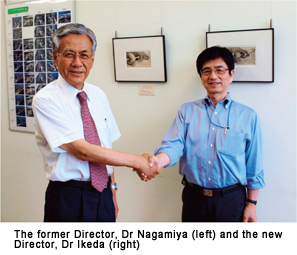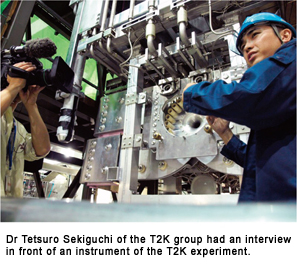| After 6 years at the helm of the J-PARC project, Dr Shoji Nagamiya formally retired at the end of June 2012. In the process he has handed the mantle of J-PARC Center Director to Dr Yujiro Ikeda who was selected after an extensive search. Dr Ikeda was formerly a Deputy Director of J-PARC Center. The new management team led by Dr Ikeda took over the reins at J-PARC from 1 July, keen to take up the challenge of leading J-PARC into the future.
Dr Nagamiya's expertise and experience will not be lost, however, as he will continue to serve as an official Advisor to J-PARC Center. |
  * Click here to enlarge. * Click here to enlarge. |
| Ā£to Page Top |
|
| ĀúProton Beam Power Continues to Increase |
| Towards the goal of achieving stable operation at 1 MW beam power, the accelerator team at J-PARC continues to make steady progress. During a three-day period at the end of June, a 275 kW proton beam was successfully delivered to the MLF target station and vital operating parameters determined. Similarly, over a 10-day period at the end of the last cycle, the Hadron Experimental Facility achieved 6 kW continuous operation for user experiments and successfully carried out extraction testing up to 14 kW. |
|
| ĀúUsers Return to the MLF after the Recovery Shutdown |
| Up until the shutdown forced by the earthquake of March 2011, the number of accepted proposals at the MLF had risen steadily year-on-year with increasing beam power and more beamlines becoming available. During the recovery shutdown, upgrade work on the accelerators continued unabated and the construction of new instruments was revived. We are very pleased to report that, as a result, in the most recent proposal round, the number of experimental proposals has surpassed pre-earthquake levels and is trending strongly upwards. With the proton beam power for user operations expected to reach 300 kW this year, the outlook for continued growth is bright. |
|
| ĀúIndustrial Usage of iMATERIA - The Ibaraki Prefecture Neutron Beamline for Materials Structure Analysis |
| More than 220 companies in Ibaraki Prefecture belong to the local Neutron Science Colloquium that was established to promote the use of the of neutron instruments at J-PARC by industry. The Annual Meeting of the Colloquium was held on 17 July 2012. At the meeting, a variety of results including a study of lithium battery materials carried out at iMATERIA were reported Major users of iMATERIA include the automotive, chemicals, electronics and materials manufacturing industries. Major research applications are hydrogen storage, lithium battery technology and organic-based display materials. |
| Ā£to Page Top |
|
| ĀúProgress on the Muon U-Beamline |
Ā@Ā@
| The S-shaped superconducting solenoid magnet for the intense ultra-slow muon beamline (U-line) has been installed, and opened to the muon community for inspection before being covered by shielding that will be required during operation. The solenoid magnet is a vital component that directs ultra-slow muons from the target onto the experimental station. |
|
| ĀúNeutrino Project Update |
Ā@Ā@
| Following the announcement at the 25th International Conference on Neutrino Physics in Kyoto in June, the J-PARC T2K neutrino experiment group presented updated results at the International Conference on High Energy Physics (ICHEP) that was held in Melbourne, Australia in July. The update reported the observation of 11 candidate events that indicate the predicted oscillation of neutrinos between muon and electron flavors. Coincident with the conference update, the T2K experiment and its results were featured in a worldwide television broadcast on 11 July. Click here more information about the T2K project. |
 |
|